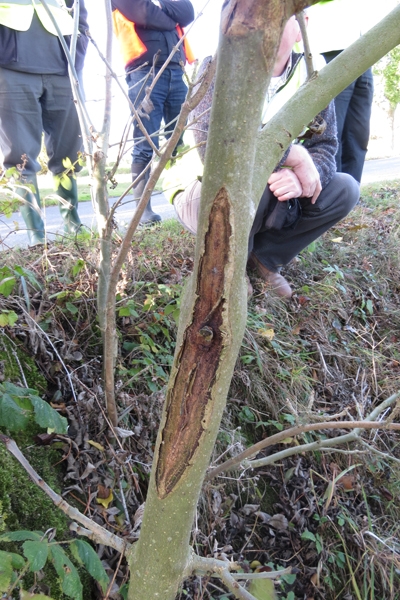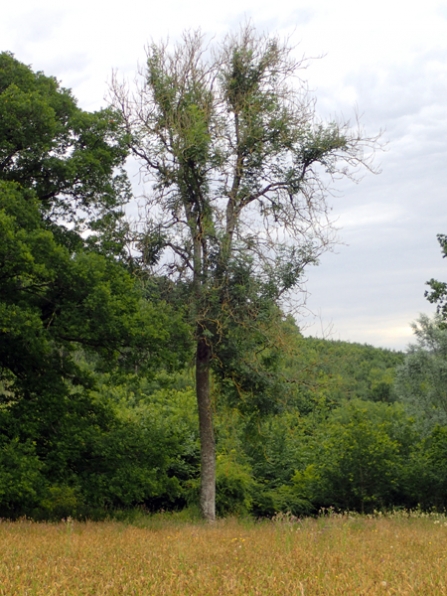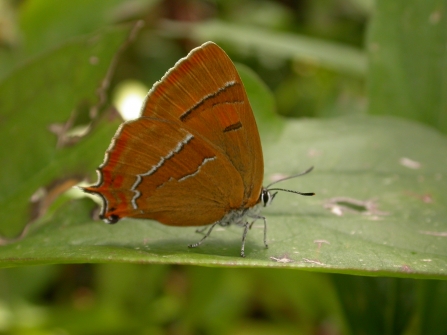
Ash leaves. Photo, Mark Hamblin/2020VISION
Ash dieback

Ash tree. Photo, Peter Wakely
Ash dieback is a devastating disease which is predicted to severely affect or kill over 90% of ash trees dramatically impacting Devon’s wooded landscapes
The disease, also known as Chalara is caused by a fungus called Hymenoscyphus fraxineus (The fungus was previously called Chalara fraxinea, hence the name of the disease.) which affects the vascular system of ash trees, inhibiting the tree’s ability to draw nutrients up into its upper branches. Young ash trees are killed very rapidly by the disease. Older trees often resist the disease for longer periods but succumb with prolonged exposure.
Ash trees are the third most common tree in Britain after oak and birch - there are 80 million ash trees in the UK. In Devon, ash dominated woodland covers about 11,000ha, 22% of all broadleaved woodland. In addition to this, there are at least 1.9 million mature ash trees outside of woodlands, for example, in hedgerows.
What does it look like?

Chalara diamond stem scar. Photo, Rob Wolton
• Wilting of leaves in summer
• Black/browning leaf, often spreading down the stem
• Black leaf may not drop as quickly as the usual autumn leaf drop
• Lesions, spots and cankers appear on the bark
• Shrivelled, contorted leaf
How is it spread?
Evidence suggests that Chalara spreads through woodlands via wind dispersal. Movement of diseased ash trees is likely to be the cause of spread over longer distances. Movement of infected logs, leaf litter and pieces of wood may also spread the disease.
What to do if you suspect a case

Mature ash tree infected with Chalara. Photo, Rob Wolton
Go to the forestry commission website for advice. Devon Wildlife Trust urge members, supporters and the general public to report potential sightings of infected trees to the Forestry Commission in the hope that the ecological impacts of this devastating disease can be minimised.
If you have a smartphone, you can download the Ashtag app to submit photos and locations of suspected ash dieback and help map the spread of the disease.
Report suspected cases to Forestry Commission: 0131 314 6414 plant.health@forestry.gsi.gov.uk
Suspected cases of ash dieback occurring on Devon Wildlife Trust nature reserves should also be reported to DWT on 01392 279244 contactus@devonwildlifetrust.org
What to do if you suspect a tree on your land has ash dieback
Infected ash trees should be left where possible. Dead ash trees remain a vital habitat for many species including birds, beetles and lichens. However, where affected trees pose a threat to the public (eg close to footpaths and bridleways) or to infrastructure (such as buildings, roads and powerlines) trees will have to be removed.
In 2019 Devon Wildlife Trust plans to begin ash dieback work across its 57 nature reserves. We will aim to keep disruption to wildlife (for example, avoiding the bird nesting season) and the public to a minimum while this vital work is undertaken.
Looking forward, it is important to act now to minimise the landscape impact of ash tree loss – start promoting new trees and taking better care of existing trees.
Use the Devon 3/2/1/ formula: When replacing affected ash trees plant at least 3 new trees for loss of a large tree, 2 for a medium tree and 1 tree for a small tree. Promote natural regeneration wherever possible, particularly in woodlands.
It is important to choose trees which have been grown in Britain by reputable nurseries, preferably from seed sourced from South West England. This will reduce the risks of introducing new diseases when planting trees.
The Devon Ash Dieback Resilience Forum has provided information on trees to replace ash, their advice note can be found here, along with lots of other helpful management advice.
History of the disease
Ash trees suffering with Chalara dieback infection have been found widely across Europe since trees now believed to have been infected with this newly identified pathogen were reported dying in large numbers in Poland in 1992. These have included forest trees, trees in urban areas such as parks and gardens, and also young trees in nurseries.
The disease was first reported in Britain in February 2012 when it was found in a consignment of infected trees sent from a nursery in the Netherlands to a nursery in Buckinghamshire.
At the end of October 2012 the Government introduced a mandatory ban on imports of ash trees, saplings or seeds and restrictions on movement of trees around the country.
The disease has now been confirmed in most regions of the UK and Ireland.
Why are ash trees important?

Brown hairstreak. Photo, Philip Precey
Ash trees are an important and integral part of our native woodland flora.
Because of their loosely-branched structure and compound leaf form, ash trees allow plenty of light through to the woodland floor. This means that a variety of plants can grow beneath them, including wild garlic, dogs mercury, bluebells, wood crane’s-bill and wood avens. Ash woodlands are often accompanied by a hazel understory.
A rich ground layer means plenty of food for insects and birds such as warblers, flycatchers and redstarts. The ash is a very long-lived tree, so can support many specialist deadwood species like the lesser stag beetle and hole-nesting birds such as owls, woodpeckers and the nuthatch. It also provides roosting space for many species of bat.
Ash bark is alkaline and supports a wide range of epiphytic lichens and bryophytes and also attracts snails. At least 60 of the rarest insect species in Britain have an association with ash – mostly rare beetles and flies. The brown hairstreak butterfly uses ash trees due to the honeydew produced by aphids. Young hairstreaks assemble around ash trees shortly after emerging - and this is also where breeding takes place.
Ash trees hold very significant cultural and historical value (veteran ash trees often mark parish boundaries for example) and have been a special feature of our ecological and visual landscape.
Working with partners
We are working with partners to protect our wildlife and increase landscape resilience to diseases such as Chalara. Our nature reserves are a vital resource in this battle. This work is only possible thanks to the support of our members and donors.
